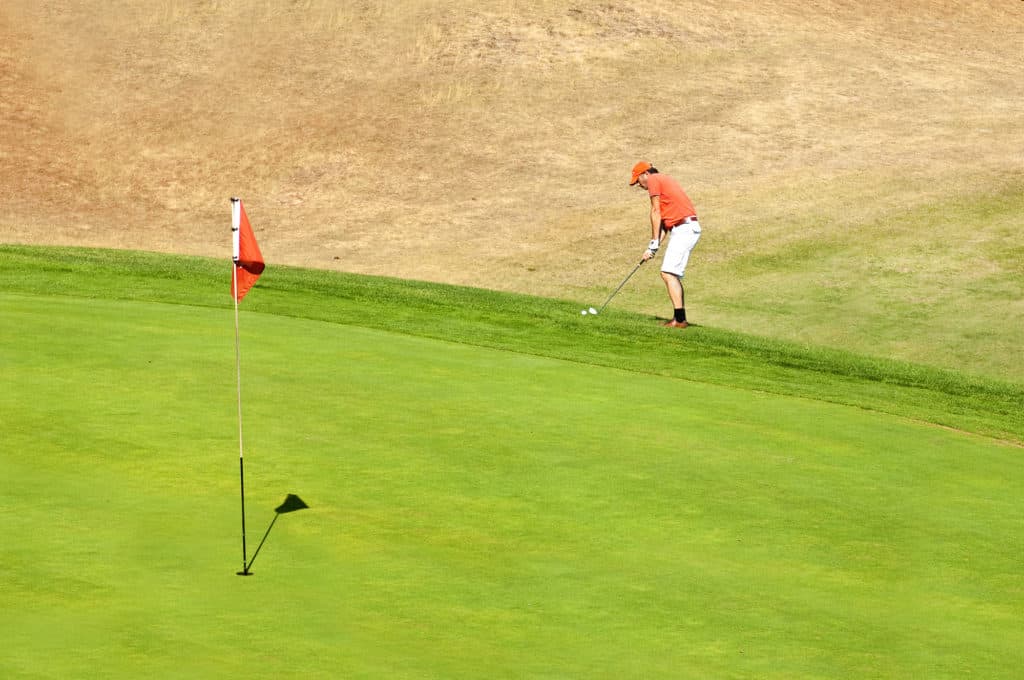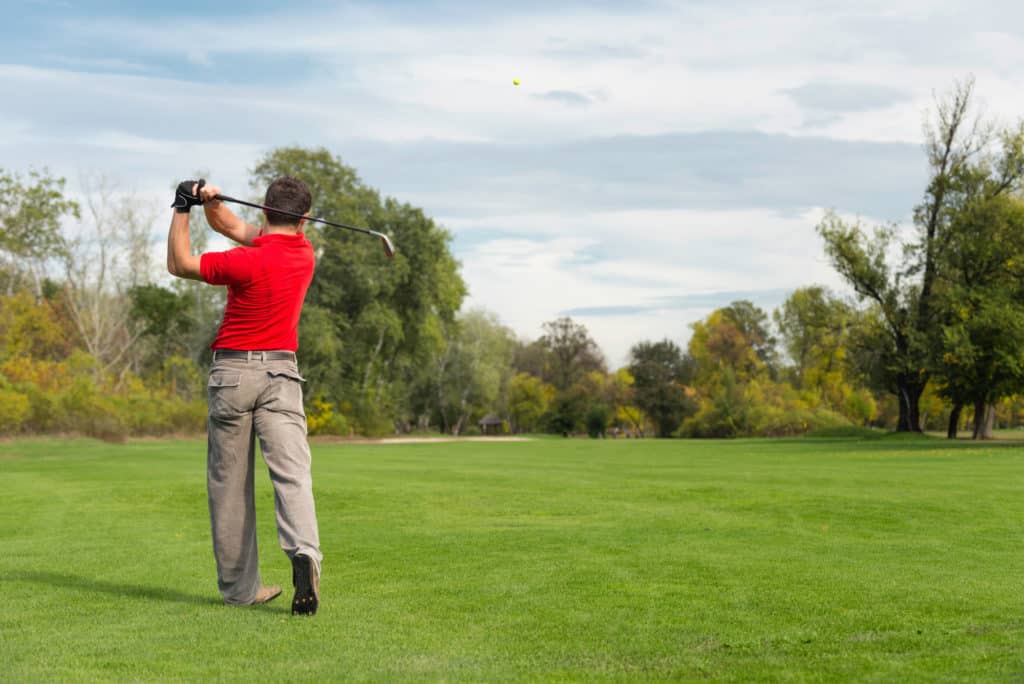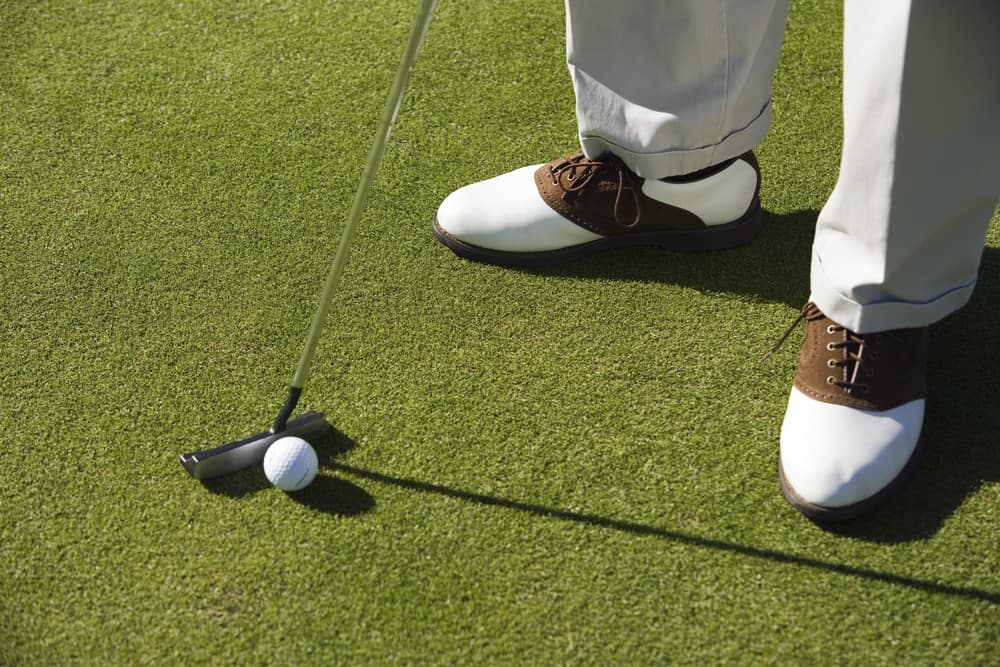
There is quite a bit of terminology in the game of golf.
Some of the lingo is easily understood, and others may have you wondering what people are talking about.
If you are new to the game, it takes a while to get comfortable with everything everybody is saying and doing.
In this guide, we will help you understand what up and down means and what you need to do to get up and down more often.
What Does Up And Down Mean In Golf?

Up and down is when your ball lands off the green, you chip your ball on and then make one putt.
The up part is considered your chip.
The down part is considered the putt where the ball goes down into the hole.
Golfers often say they have to “get up and down” to save par or bogey.
Getting up and down is essential because it can help save your score on a hole that may be getting away from you.
How You Can Make More Up and Downs

All golfers want to get up and down more because it will have a significant impact on your score.
There are some things that you can do to help get up and down more often.
Learn More Types of Shots
The best way to get better at making up and downs are to have a variety of different shots that you can hit.
If all you know how to do is hit your sand wedge to the center of the green, you will have some trouble when you are in the rough or sand, etc.
You should be able to hit a variety of shots with each wedge in your bag.
For instance, you should be able to hit a high flying lob shot with a 56-degree wedge that lands almost at the pin and stops quick.
You should also be able to hit this same wedge so that it flies part of the way to the hole and then rolls the rest of the way.
Finally, you should be able to close the clubface on the club slightly, hit it a ¼ of the way to the hole, and let it roll out the rest.
When you have a variety of different shots that you can hit, there will be no lies that scare you or make you worried about your results.
Practice Making 6-8 Foot Putts
Golfers that get up and down can make more than just tap ins to save the up and down.
If you end up hitting the ball on the green, you want to make sure that you have a chance to make the putt.
Even a great chip can sometimes leave you with a 6-8 foot putt to make.
This is a challenging putting distance, and it will separate the low and high handicap players.
One of the best ways to practice these lengths putts is to start at one foot.
Make a one-foot putt and then move to a two-foot putt.
If you make that two-foot putt, then move to a three-foot putt; if you miss, then you must start over.
This drill is quite tricky, and it will take a bit of time to master, but it is very effective.
It makes you focus on each putt that you hit because you don’t want to have to start all over at the one footer each time.
Read the Greens
Amateur golfers do not understand the importance of reading a green before you have a putter in your hand.
When you are chipping onto the green, you should be paying attention to the shape of the green, the way it’s tilted, and any apparent tiers.
If the pin is on the back tier of the green and you chip up and leave the shot on the front tier, this is not a good chip.
If you get it to the back tier, you have a much better chance of getting up and down.
Some golfers chip the ball to get it on the green.
However, it would help if you were chipping the ball to get it in the hole.
There is no reason not to try and make a chip shot.
Sinking your chip shot is much better than an up and down from a scoring perspective.
When chipping onto the green, start to get into the mindset that you are going to try and sink the chip shots, not just hit them onto the green.
Think About The Putt You Are Leaving Yourself
Pay attention to where the hole is and where you want to be putting from.
You can be very close to a hole but have a three-foot downhill slider, or you can have a dead straight four-footer up the hill.
These two putts are going to be much different animals, and they will impact your ability to get up and down.
Think about the part of your putting game that is the strongest.
Try to set yourself up for putts that you know you can make.
Watch Your Approach Shot
Sometimes the reason people can’t get up and down is that they don’t put themselves in a position to be able to do so.
If you are hitting your approach shot to the green with a club in your hand that you are not comfortable with, you may want to consider it.
Let’s say you have 180 yards to the green, and you decide to try and hit a four-iron as far as you possibly can.
You know that you can hit this shot one out of ten times.
A great player will take a swing with a 160-yard club and land it short of the green.
They will go up to their shot that is perfectly placed in the center of the fairway, chip one, and one putt.
The player that tried to push that four iron is likely still in the bunker or taking a drop from the water hazard.
If you want to get great at making up and downs, you need to pay attention to where you are leaving your shots.
Does It Count As An Up and Down If You Were On the Fringe

Some people wonder what makes an up and down truly count.
If you are off the green and hit your shot on and make one putt, it’s considered an up and down.
Some people even consider it an up and down when you are 150 yards out, hit it on the green, and make one putt.
Traditionally the up and down is considered a chip on, and one putt or a bunker shot up and one putt.
Sometimes golfers will keep track of ups and downs because they are using it for betting.
In this case, the up and down may be limited to the shots around the green only.
Conclusion
Getting up and down means that you hit the ball on the green and get it in the hole with one putt.
This is a very efficient way to get around the golf course and will lead to lower scores.
Great golfers that miss a shot know that they just need to get up and down to be able to save their score.



Leave a Reply